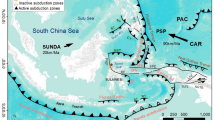Abstract
The Hyuga-nada region of southwest Japan, which is located off the east coast of Kyushu Island, may have the potential to generate great interplate earthquakes along the Nankai trough in the future. In this area, thrust earthquakes of M = 6.7–7.2 have occurred with recurrence intervals of approximately 30 years. In association with these earthquakes, possible local heterogeneities of plate coupling may be expected within 100 km from the coast in the Hyuga-nada region. We investigate numerical experiments to determine the spatial and temporal resolution of slip on the plate interface beneath the Hyuga-nada offshore region. For this purpose, we calculated synthetic displacement data from the result of numerical simulation conducted for the afterslip following an Mw 6.8 earthquake, for existing global positioning system stations on land and planned ocean floor seismic network stations. The spatial and temporal distribution of fault slip is then estimated using a Kalman filter-based inversion. The slip distribution estimated by using ocean floor stations demonstrates that the heterogeneity of plate coupling is resolved approximately within 50 km from the coastal area. This heterogeneity corresponds to the coseismic area of an Mw 6.8 earthquake with a radius of 10 km. Our study quantitatively evaluates the spatial resolution of aseismic slip in the Hyuga-nada region. Analysis based on continuous ocean floor data is useful for resolving the spatial variations of heterogeneities in plate couplings.






Similar content being viewed by others
References
Baba T, Tanioka Y, Cummins PR, Uhira K (2002) The slip distribution of the 1946 Nankai earthquake estimated from tsunami inversion using a new plate model. Phys Earth Planet Inter 132:59–73
Baba T, Hirata K, Hori T, Sakaguchi H (2006) Offshore geodetic data conducive to the estimation of the afterslip distribution following the 2003 Tokachi-oki earthquake. Earth Planet Sci Lett 241:281–292
Dieterich JH (1979) Modeling of rock friction. 1. Experimental results and constitutive equations. J Geophys Res 84(B 5):2161–2168
Fukuda J, Higuchi T, Miyazaki S, Kato T (2004) A new approach to time-dependent inversion of geodetic data using a Monte Carlo mixture Kalman filter. Geophys J Int 159:17–39. doi:10.1111/j.1365-246X.2004.02383.x
Furumura T, Imai K, Maeda T (2011) A revised tsunami source model for the 1707 Hoei earthquake and simulation of tsunami inundation of Ryujin Lake, Kyushu, Japan. J Geophys Res 116:B02308. doi:10.1029/2010JB007918
Hatori T (1985) Field investigation of historical tsunamis along the east coast of Kyushu, west Japan. Bull Earthq Res Inst Univ Tokyo 60:439–459
Headquarters for Earthquake Research Promotion (2004) Long-term evaluation of seismicity off Hyuga and Southwestern Islands areas along Ryukyu trench
Ito Y, Hino R, Kido M, Fujimoto H, Osada Y, Inazu D, Ohta Y, Iinuma T, Ohzono M, Miura S, Mishina M, Suzuki K, Tsuji T, Ashi J (2013) Episodic slow slip events in the Japan subduction zone before the 2011 Tohoku-Oki earthquake. Tectonophysics 600:14–26
Kaneda Y, Kawaguchi K, Araki E, Matsumoto H, Yokobiki T, Nakamura T, Kamiya S, Ariyoshi K, Baba T, Ohori M, Takahashi N (2011) Advanced ocean floor network system for megathrust earthquakes and tsunamis—DONET and DONET2 projects around the Nankai trough. AOGS Asia Oceania Geosciences Society
Kato N, Tullis TE (2001) A composite rate- and state-dependent law for rock friction. Geophys Res Lett 28(6):1103–1106
Nakata R, Hyodo M, Hori T (2012) Numerical simulation of afterslips and slow slip events that occurred in the same area in Hyuga-nada of southwest Japan. Geophys J Int 190:1213–1220. doi:10.1111/j.1365-246X.2012.05552.x
Nakatani M (2001) Conceptual and physical clarification of rate and state friction: frictional sliding as a thermally activated rheology. J Geophys Res 106(B7):13347–13380
Rice JR (1993) Spatio-temporal complexity of slip on a fault. J Geophys Res 98(B6):9885–9907
Savage JC (1983) A dislocation model of strain accumulation and release at a subduction zone. J Geophys Res 88(B6):4984–4996
Segall P, Matthews M (1997) Time dependent inversion of geodetic data. J Geophys Res 102(B10):22391–22409
Wessel P, Smith WHF (1998) New, improved version of generic mapping tools released. EOS Trans Am Geophys Union 79:579
Yagi Y, Kikuchi M, Sagiya T (2001) Co-seismic slip, post-seismic slip, and aftershocks associated with two large earthquakes in 1996 in Hyuga-nada, Japan. Earth Planet Space 53:793–803
Yamanaka Y, Kikuchi M (2004) Asperity map along the subduction zone in northeastern Japan inferred from regional seismic data. J Geophys Res 109:B07307. doi:10.1029/2003JB002683
Yamashita Y, Shimizu H, Uehira K, Fujii M (2011) Hypocenter relocation of major earthquakes and the comparison with the interplate quasi-static slip rate in the Hyuga-nada, SW Japan subduction zone. IUGG, abstract
Yarai H, Ozawa S (2013) Quasi-periodic slow slip events in the afterslip area of the 1996 Hyuga-nada earthquakes, Japan. J Geophys Res 118:2512–2527. doi:10.1002/jgrb.50161
Acknowledgments
The comments from two anonymous reviewers and the editor were constructive and helped improve this manuscript. This work was partly supported by the project “Evaluation and disaster prevention research for the coming Tokai, Tonankai, and Nankai earthquakes” of the Ministry of Education, Culture, Sports, Science and Technology (MEXT) of Japan. We used Generic Mapping Tools (Wessel and Smith 1998) to draw all figures.
Author information
Authors and Affiliations
Corresponding author
Rights and permissions
About this article
Cite this article
Nakata, R., Miyazaki, S., Hyodo, M. et al. Reproducibility of spatial and temporal distribution of aseismic slips in Hyuga-nada of southwest Japan. Mar Geophys Res 35, 311–317 (2014). https://doi.org/10.1007/s11001-013-9199-z
Received:
Accepted:
Published:
Issue Date:
DOI: https://doi.org/10.1007/s11001-013-9199-z




